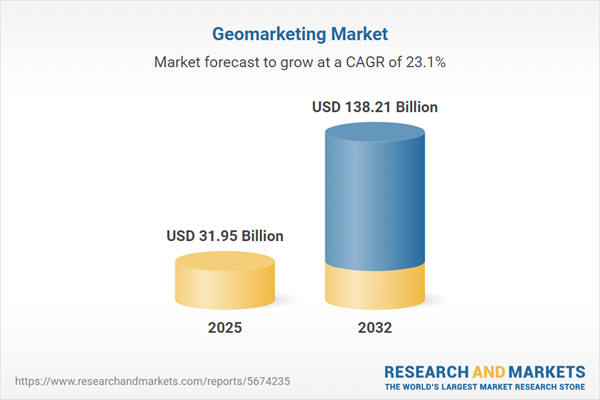Speak directly to the analyst to clarify any post sales queries you may have.
Geomarketing is rapidly transforming how enterprises target, engage, and understand customers by leveraging location intelligence, advanced analytics, and next-generation wireless technologies within their marketing strategies.
Geomarketing Market Snapshot
The geomarketing market is exhibiting robust growth, advancing from USD 26.15 billion in 2024 to USD 31.95 billion in 2025, with a projected compound annual growth rate (CAGR) of 23.13%. By 2032, the market is anticipated to reach USD 138.21 billion.
Enterprises are embracing geomarketing to harness real-time location-based insights, adapting strategies to increase marketing efficiency and drive customer relevance across industries and geographies.Scope & Segmentation
- Component: Services such as consulting, integration, managed services, support and maintenance, and a range of software encompassing data integration, geocoding, analytics, mobile applications, and visualization.
- Technology: Bluetooth, cellular networks, GPS, RFID, and Wi-Fi are utilized based on campaign requirements for accurate indoor and outdoor positioning.
- Location Type: Solutions are tailored for both indoor and outdoor geomarketing applications, accounting for signal density and coverage needs.
- Deployment Mode: Flexible deployment models offer cloud-based or on-premise solutions, supporting scalability and data sovereignty requirements across industries.
- Application: Key uses include campaign management, benchmarking, customer and foot traffic analysis, advertising, territory mapping, site planning, social media monitoring, and sentiment analysis.
- Organization Size: Offerings support both large enterprises focused on global reach and SMEs seeking local or niche campaign optimization.
- End-Use: The market serves sectors such as BFSI, IT & telecom, media & entertainment, retail & e-commerce, and travel & hospitality.
- Region: Americas (including the US, Canada, Mexico, and several Latin American countries), Europe, Middle East & Africa (UK, Germany, France, UAE, South Africa, among others), and Asia-Pacific (China, India, Japan, Australia, others).
- Company Coverage: Analysis includes Adobe Inc., CartoDB Inc., Cisco Systems, Cloud4Wi, Dista Technology, Galileo SAS, Geoapify, GEOBLINK, GeoMoby, Google LLC, IBM, Mapbox, and Microsoft.
Key Takeaways for Senior Decision-Makers
- The convergence of location intelligence and marketing is enabling more relevant, real-time customer targeting through enhanced data integration and mobile connectivity.
- Geospatial analytics and positioning technologies empower both large enterprises and SMEs to deploy hyperlocal or global campaigns with improved accuracy and customer resonance.
- Stringent privacy regulations are accelerating the adoption of anonymization, consent management, and privacy-preserving data practices, affecting technology selection and process redesign.
- Managed service providers and technology vendors are forging new partnerships and service models to adapt to rapid shifts in infrastructure and regulatory expectations.
- Wireless and IoT innovation is foundational for optimized geomarketing across different environments, supporting indoor tracking and outdoor navigation for diverse industries.
Tariff Impact and Supply Chain Response
The introduction of US tariffs in 2025 has injected complexity into supply chains for geomarketing hardware and supporting infrastructure. Vendors are diversifying sourcing, reshoring manufacturing, and leveraging free trade zones to maintain continuity and manage costs. Enterprises are adapting with alternative procurement strategies, contract renegotiation, and innovative hardware customization to mitigate supply risks and safeguard project timelines.
Advanced Methodology & Data Sources
This report utilizes comprehensive secondary research, including industry publications, market filings, and technical documentation, supplemented by primary interviews with industry experts, technology providers, and client organizations. Analytical rigor is achieved through triangulation, spatial regression, and sentiment analysis to ensure relevance and accuracy.
Why This Report Matters
- Gain strategic clarity on evolving regional dynamics, regulatory requirements, and segmentation to inform better investment and operational decisions.
- Support roadmap planning by understanding supplier, technology, and service provider shifts impacting innovation and deployment speed.
- Empower leadership teams to navigate post-tariff market changes and leverage emerging geospatial intelligence for business growth.
Conclusion
Geomarketing is reshaping customer engagement with actionable location-driven insights. Decision-makers using this research will be equipped to anticipate industry trends, mitigate regulatory risks, and maximize value from next-generation marketing strategies.
Additional Product Information:
- Purchase of this report includes 1 year online access with quarterly updates.
- This report can be updated on request. Please contact our Customer Experience team using the Ask a Question widget on our website.
Table of Contents
3. Executive Summary
4. Market Overview
7. Cumulative Impact of Artificial Intelligence 2025
Companies Mentioned
The companies profiled in this Geomarketing market report include:- Adobe Inc.
- CartoDB Inc.
- Cisco Systems, Inc.
- Cloud4Wi, Inc.
- Dista Technology Pvt. Ltd.
- Galileo SAS
- Geoapify
- GEOBLINK SL
- GeoMoby Pty Ltd.
- Google LLC by Alphabet Inc.
- International Business Machines Corporation
- Mapbox, Inc.
- Microsoft Corporation
Table Information
| Report Attribute | Details |
|---|---|
| No. of Pages | 197 |
| Published | November 2025 |
| Forecast Period | 2025 - 2032 |
| Estimated Market Value ( USD | $ 31.95 Billion |
| Forecasted Market Value ( USD | $ 138.21 Billion |
| Compound Annual Growth Rate | 23.1% |
| Regions Covered | Global |
| No. of Companies Mentioned | 14 |









